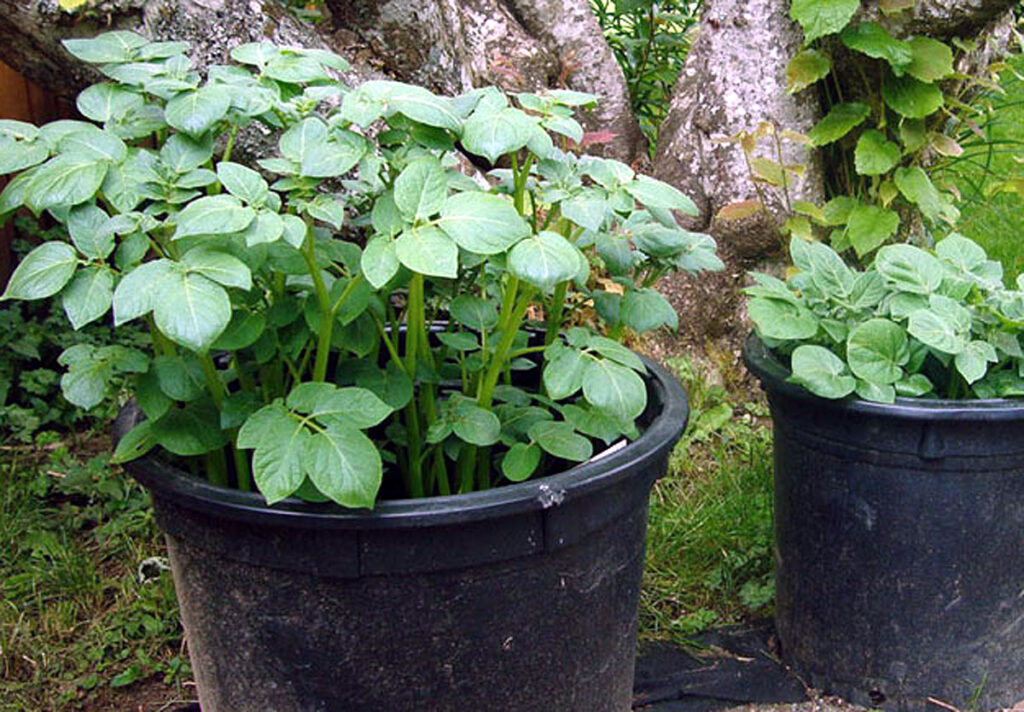Growing potato in pots
Compared to growing potatoes (Solanum tuberosum) in the ground, growing potatoes in pots has a number of advantages. One of the most significant advantages is that it is easier to prevent insects such as voles from eating the plants.
Children will also enjoy doing container potatoes. It demands a small amount of space for the plants to increase, resulting in a good yield.
Potatoes cultivated in containers have one major drawback: they need to be watered more frequently since container soil dries out faster than ground soil. Retaining moist but not waterlogged soil is essential. It is important to check the soil moisture regularly and to water deeply so you can harvest potatoes abundantly.

Best time to growing potato indoors
Potatoes can be planted in containers the same way they are in the ground. In general, it is recommended to plant potatoes in the ground two weeks before the last frost. A late spring frost may cause your potato containers to freeze. Be prepared to cover or move them indoors if that happens. Winter is a great time to growing potato indoors if you have enough heat and light. It is ordinary for individuals to grow them in greenhouses during the winter.
Potatoes purchased from the grocery store should not be used to produce potatoes in containers unless they have been organically grown and have not been sprayed to prevent sprouting. Obtain “seed” potatoes at nurseries or specialty organic planters for planting in your garden.

Hilling the Potatoes
Planting potatoes in containers leads to vertical growth, and a pot makes it comfortable to hill and contains the process. As long as your potatoes receive the proper soil and moisture requirements, they will produce bumper yields. A considerable pot of any kind is essential for producing potatoes successfully. Ideally, they should be at least 14 inches wide at the bottom so they can be hilled throughout the growing season.
A container garden can be crowded a bit with potatoes, which are usually planted 10 inches apart. The bottom of a pot with a diameter of 14 inches will be large enough for three starter plants, and it is best to use a pot at least 15 inches deep. As a result, at least two inches of growing medium can be spread under the starts, and mild hilling can be achieved. At the end of hilling, mulch can be added to your garden or container to support it retain moisture.
Sunlight
The potato pot should be placed in a sunny, frost-free location. Planting potatoes in containers in full sun is ideal, though it should be avoided that their crops overheat as a result of too much direct sunlight. It is vital that you provide your container with at least six to eight hours of sunlight each day.
Watering
In order to ensure potatoes receive the right amount of water during different stages of their growth, you need to adjust the water requirements slightly throughout the growing season. Watering containers is typically necessary every 1-3 days, depending on the climate.
To prevent potato roots from setting in dripping wet soil, use a container with drainage holes and at least two inches of gravel in the base.

Soil
It’s just as necessary to choose the suitable potting mix as to pick the suitable container. Growing potato in containers need rich, well-drained, loamy soil, just like their garden equivalents. The most suitable soil to use for potatoes is a blend of organic potting soil and compost, which can be supplemented with sand. You should add a few handfuls of well-balanced organic fertilizer when you are mixing your soil with compost.
Temperature
In spite of the fact that root growth occurs at temperatures between 10 and 35 degrees Celsius (50 and 95 degrees Fahrenheit), the best, most active growth occurs at temperatures between 15 and 20 degrees Celsius (59 and 68 degrees Fahrenheit).

Fertilizing
It’s essential to prefer a product with a higher phosphorus number than a higher nitrogen number since potatoes need nitrogen to grow nourishing green leaves, and phosphorus is vital to growing tubers. An ideal synthetic fertilizer is one with a nutrient ratio of 5-10-10.
Hilling can also be done with straw, hay, partially composted leaves or standard compost. Potatoes are formed above, not below the seed potatoes. Adding organic vegetable fertilizer to the pile of “hilling” material keeps them healthy.
Read also:
How to Grow Potatoes at home. Container gardening. How to Grow sweet potatoes at home.
For pin:





